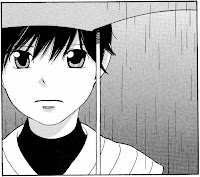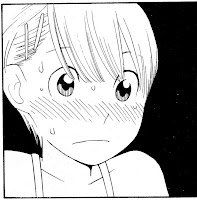 |
| © Moyoco Anno |
The January 2013 Manga Moveable Feast (January 20-January 26), hosted right here at Experiments in Manga, features Moyoco Anno and her works. This page serves as the Feast’s archive and links to posts contributed to the Feast as well as to earlier reviews, interviews, and articles.
Call for Participation
An Introduction
Roundup One
Roundup Two
Roundup Three
A Final Farewell
Reviews:
Flowers & Bees, Volume 1 (Experiments in Manga)
Happy Mania, Volume 1 (Experiments in Manga)
Happy Mania, Volumes 1-5 (Manga Report)
Japan as Viewed by 17 Creators (Experiments in Manga)
Sakuran (Experiments in Manga)
Sakuran (Manga Xanadu)
Sakuran (Nagareboshi Reviews)
Sugar Sugar Rune, Volume 1 (Experiments in Manga)
Other contributions:
How a Non-Manga Fan Got Me Into Sakuran (Experiments in Manga)
Interview: Moyoco Anno “I really don’t like women that much!” (The Beat)
Moyoco Anno’s Study of the Bitch (All About Manga)
My Week in Manga (Experiments in Manga)
My Week in Manga: Moyoco Anno Edition (Manga Bookshelf)
From the archives (pre-Feast content):
Moyoco Anno at New York Comic Con 2012
Manga Interview: Moyoco Anno (MTV Geek)
New York Comic Con 2012: Moyoco Anno (Reverse Thieves)
Part 1: Moyoco Anno and the Madding Crowd (Sequential Tart)
Part 2: Moyoco Anno on Clueless Boys, Career Women, and Courtesans (Sequential Tart)
Vertical Inc Presents Moyoco Anno Panel (Anime News Network)
Chameleon Army (1995-1997)
Chameleon Army (Brain Vs. Book)
Happy Mania (1995-2001)
Happy Mania, Volume 1 (Manga Worth Reading)
Happy Mania, Volume 1 (Sesho’s Anime And Manga Reviews)
Happy Mania, Volume 1 (Slightly Biased Manga)
Happy Mania, Volume 2 (Manga Worth Reading)
Happy Mania, Volume 2 (Sesho’s Anime And Manga Reviews)
Happy Mania, Volume 3 (Sesho’s Anime And Manga Reviews)
Happy Mania, Volume 4 (Sesho’s Anime And Manga Reviews)
Happy Mania, Volume 8 (Manga Worth Reading)
Happy Mania, Volume 9 (Manga Worth Reading)
Happy Mania, Volume 11 (Slightly Biased Manga)
Happy Mania (Jason Thompson’s House of 1000 Manga)
Flowers & Bees (2000-2003)
Flowers & Bees, Volume 1 (Comics-and-More)
Flowers & Bees, Volume 1 (Slightly Biased Manga)
Flowers & Bees, Volume 2 (Slightly Biased Manga)
Flowers & Bees, Volume 3 (Slightly Biased Manga)
Flowers & Bees, Volume 6 (Slightly Biased Manga)
Flowers & Bees, Volume 7 (Slightly Biased Manga)
Flowers & Bees (Jason Thompson’s House of 1000 Manga)
8 Reasons Why You Should Read or Revisit Moyoco Anno’s Flowers and Bees (Uncharted Territory)
Sakuran: Blossoms Wild (2001-2003)
Sakuran (Anime News Network)
Sakuran (A Case Suitable for Treatment)
Sakuran (Comic Attack)
Sakuran (Comics-and-More)
Sakuran (Genji Press)
Sakuran (Heart of Manga)
Sakuran (The Manga Critic)
Sakuran (Manga Test Drive)
Sakuran (Manga Worth Reading)
Sakuran (Matt Talks About Manga)
Sakuran (Otaku USA)
Sakuran (Slightly Biased Manga)
Moyoco Anno’s ‘Sakuran’ Tackles ‘Difficult’ Women in a Difficult Time [Exclusive Preview] (Comics Alliance)
Off the Shelf: Sakuran (Manga Bookshelf)
Sakuran – Is It Our Nature to Decieve? (Manga Therapy)
Sugar Sugar Rune (2003-2007)
Sugar Sugar Rune, Volume 1 (Sixty Minute Manga)
Sugar Sugar Rune, Volume 1 (Slightly Biased Manga)
Sugar Sugar Rune, Volume 2 (Slightly Biased Manga)
Sugar Sugar Rune, Volume 3 (Slightly Biased Manga)
Sugar Sugar Rune, Volume 4 (Slightly Biased Manga)
Sugar Sugar Rune, Volume 5 (Slightly Biased Manga)
Sugar Sugar Rune, Volume 6 (Slightly Biased Manga)
Sugar Sugar Rune, Volume 7 (Manga Maniac Cafe)
Sugar Sugar Rune, Volume 7 (Slightly Biased Manga)
Sugar Sugar Rune, Volume 8 (Slightly Biased Manga)
Sugar Sugar Rune, Volumes 1-8 (Graphic Novel Reporter)
13 Days of Halloween: Sugar Sugar Rune (Kuriousity)
Overlooked Manga Festival: Sugar Sugar Rune (Shaenon K. Garrity)
Japan as Viewed by 17 Creators (2005)
Japan as Viewed by 17 Creators (Graphic Novel Reporter)
Japan as Viewed by 17 Creators (Japan Reviewed)
Japan as Viewed by 17 Creators (Jason Thompson’s House of 1000 Manga)
Japan as Viewed by 17 Creators (The Manga Curmudgeon)
Japan as Viewed by 17 Creators (Read About Comics)
Japan as Viewed by 17 Creators (Slightly Biased Manga)












